THE KUBA TEXTILES FROM THE DRC – 2
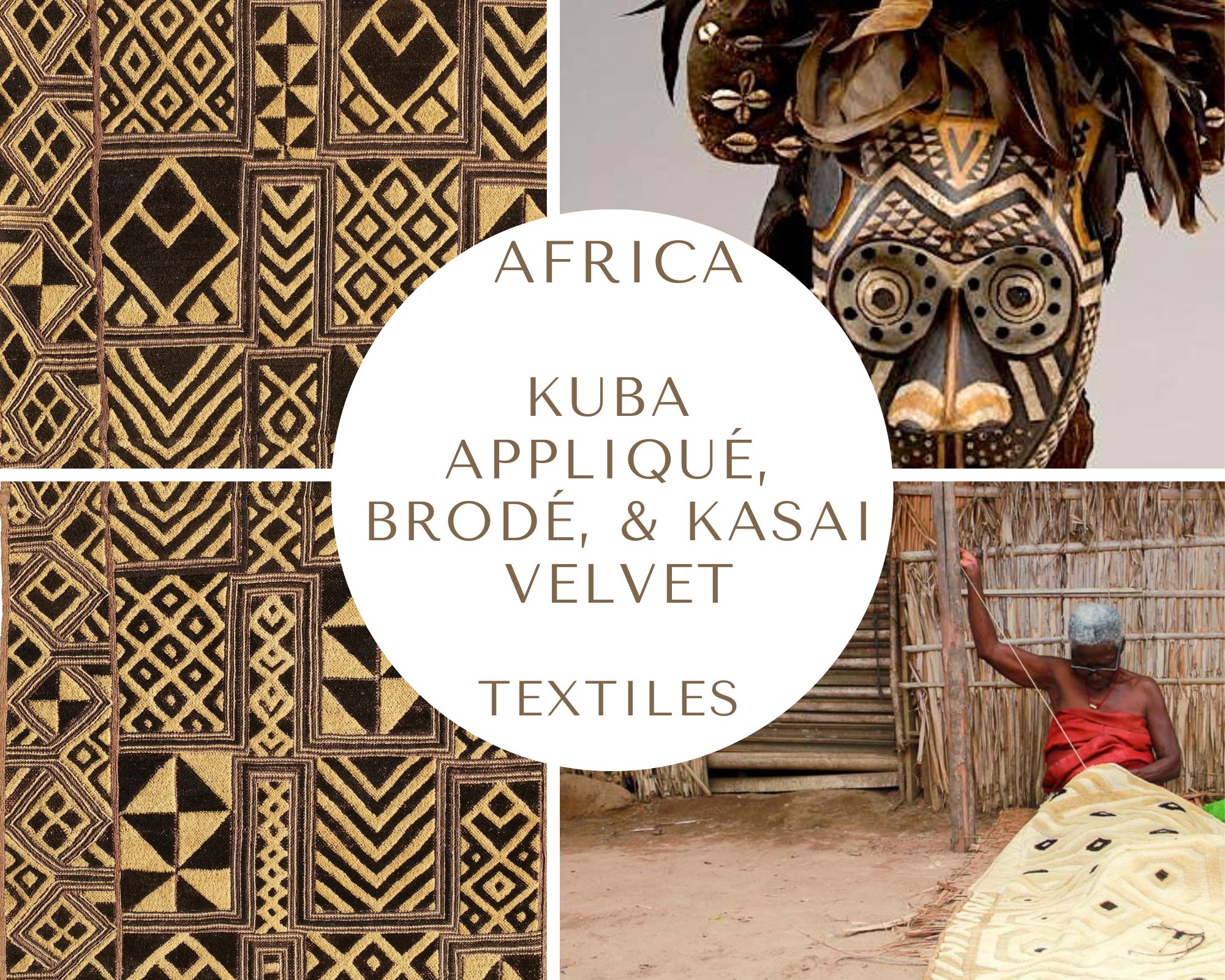
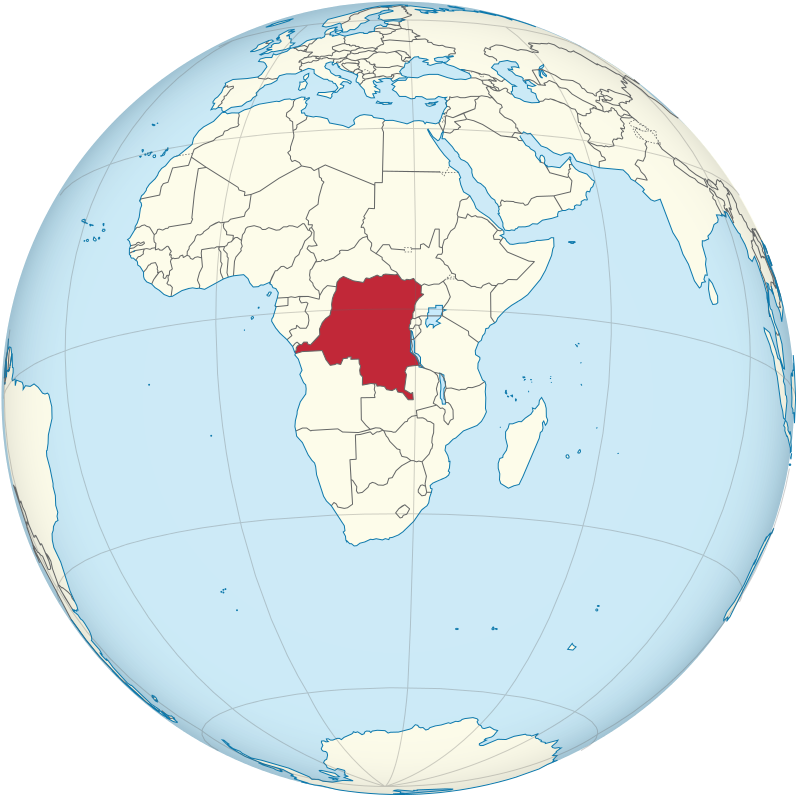
Democratic Republic of the Congo or DRC on the globe (licensed under the Creative Commons Attribution-Share Alike 3.0 Unported)
THE CORE OF SHOOWA VELVETS: EXPECTING THE UNEXPECTED
When we look at a detail of a Shoowa panel or a Kasaï Velvet, we see a regular geometric pattern or a well-ordered composition of geometric patterns. If we look at the whole panel, we’ll usually see something completely different: the vast majority of Shoowa panels and many Kasaï Velvets start one way and end another. Yes, they begin and end dynamically, just like a piece of music. And like the song by the Congolese musician Mumba Yachi or many pieces of traditional sub-Saharan music, the way a piece begins is often very different from the way it ends. In other words, the beginning is by no means indicative of the end. After all, human life is a bit like that: we wait for the unexpected because we know it will come sooner or later, but we don’t know what the hell it will be like…
The Kasaï panel below is a single fragment of a larger one, made in what is now the Democratic Republic of Congo between 1900 and 1949. It looks well preserved, but is probably more than a hundred years old.
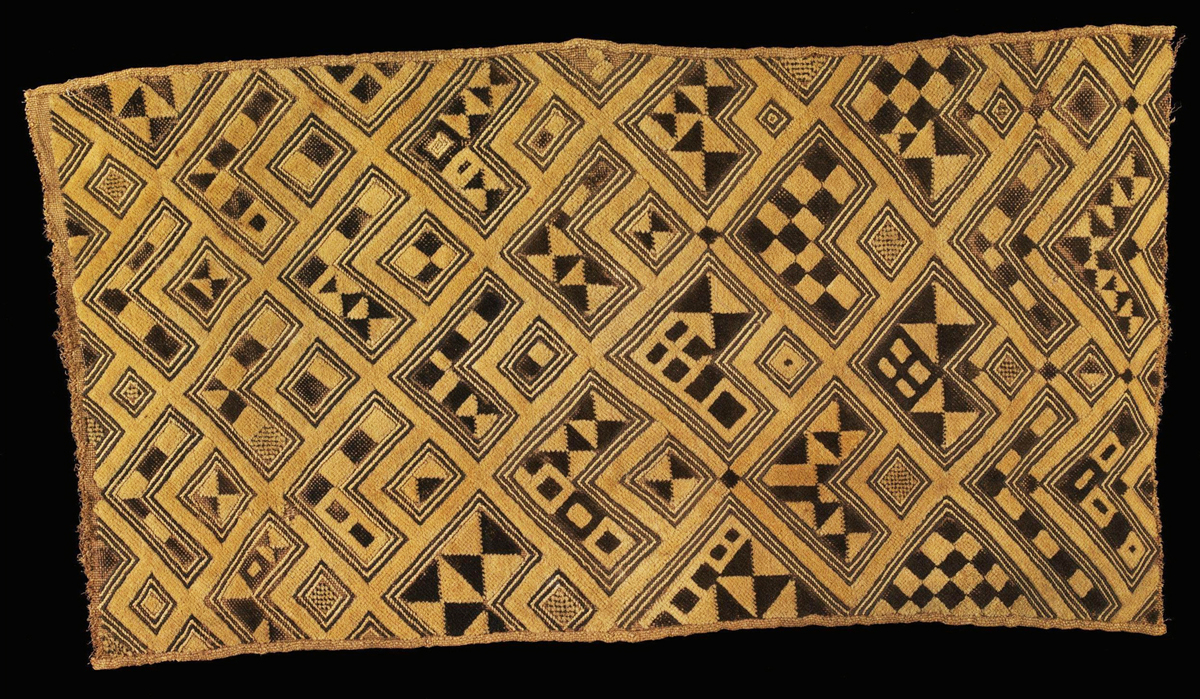
Fragment of a raffia panel, Kuba people, DRC, 1900-1949. Dimensions: width 48 cm – 50 in; length 81 cm – 131.6 cm. Victoria & Albert Museum, London, UK.
Let’s look at its geometric pattern: there’s a symmetrical and ordered arrangement in three-quarters of the entire space – in the last quarter on the right, things start to change. The space shows regular rows of L-shaped blocks, each completed by a quadrilateral on their opposite corner. The overall order becomes more evident if you look at the so-called “streets”, namely the empty paths that separate the rows of L-shaped blocks and the smaller four-sided shapes. And if you look closely, you will see that no two L-shaped blocks are the same: they vary in size, shape, interior design, and color pattern. Even the quadrilaterals (some are squares, some are rectangles) are all different, but they always occupy the same position (= the free corner of the ideal quadrilateral in which each L-block is inscribed).
We can describe this complex geometric pattern in musical terms. The regular rows of L-shaped blocks for 3/4 of the space is here a repetitive element, an ostinato. A musical ostinato is a repeated motif or musical phrase within a composition; it’s a repeating element that can consist of a sequence of notes, a specific rhythm, or a combination of both. The purpose of an ostinato is to create a recognizable focal point within a musical or a visual composition, contributing to the unity and cohesion of the work.
The quadrilaterals are the visual counterparts of musical contrapuntal elements: they form a separate melodic line or voice (counterpoint, contrappunto) that develops independently in rhythm and melodic contour, but interacts with or complements the main motif, the ostinato, creating a complex and harmonious musical/visual texture.
Thus, in music, the ostinato is a kind of main theme, and the variations are reinterpretations of the original theme, which may involve changes in melody, harmony, rhythm, or overall structure. Here in our panel, we have variations of both the ostinato and the contrapuntal elements, and these variations involve changes in design, figure dimensions, and colors. The ostinato is constantly and dynamically reinterpreted, and all these variations breathe new life into the theme, offering different shades and points of interest to the composition. In other words, the ostinato is the foundation from which variations develop, adding depth, complexity, and interest to the entire work.
At a certain point in space and time, the various geometric patterns or melodic lines break apart and something happens: the L-shaped blocks lose their contrapuntal quadrangles, which are still there but no longer in their previous positions; the overall structure seems to lose order and the geometric elements seem to be left to themselves for a moment, waiting to be reorganized into a new complex pattern, which we do not see because the panel is only a fragment. Musically, the ostinato and contrapuntal elements remain, but the pre-existing harmony and melody have disappeared, perhaps to give rise to something new, which we do not hear because the composition breaks down.
Before moving on to other musical/visual compositions, we must emphasize an important aspect of Shoowa panels. The presence of variations introduces a change, a dynamic element. This takes on a different pace depending on how we look at the panel. We know that Kuba women generally sewed the panels from top to bottom and from left to right (sources: G. Meurant, Sam Hilu and Irwin Hersey), without any preliminary drawings on the cloth. However, there is nothing to tell us that the panels should be seen only in this way, or that the order in which they were made is the order in which they must be viewed: top-to-bottom and left-to-right may be privileged, special perspectives, but not the only “authorized” points of view. The strongly rectangular panels, which probably had to be sewn together, should be viewed horizontally first, but the square individual panels can theoretically be viewed in all possible ways. In short, they are not like the masterpieces of European abstractionism, with well-defined and unchanging top, bottom, left, and right.
BELOW
Kuba women sewing panels, DRC. Photo courtesy by Malaika Ngoy, founder and owner of Shoowa Kingswear.
The following panel is an ancient piece of a woman’s overskirt made in Mushenge, the capital of the Kuba kingdom (in present-day DRC), in the 19th century. Two different ostinato elements can be clearly seen: the triangular one on the upper and lower borders, and the vertical frieze pattern on the central part. The panel shows two types of variations: one on the triangular border pattern and the other on the central vertical pattern. The latter involves a slight color change in the design and consistent variations of all contrapuntal elements, and follows a certain degree of order and regularity, while the variation on the border pattern involves changes in design, figure size, and color, and seems freer from formal constraints and more spontaneous.
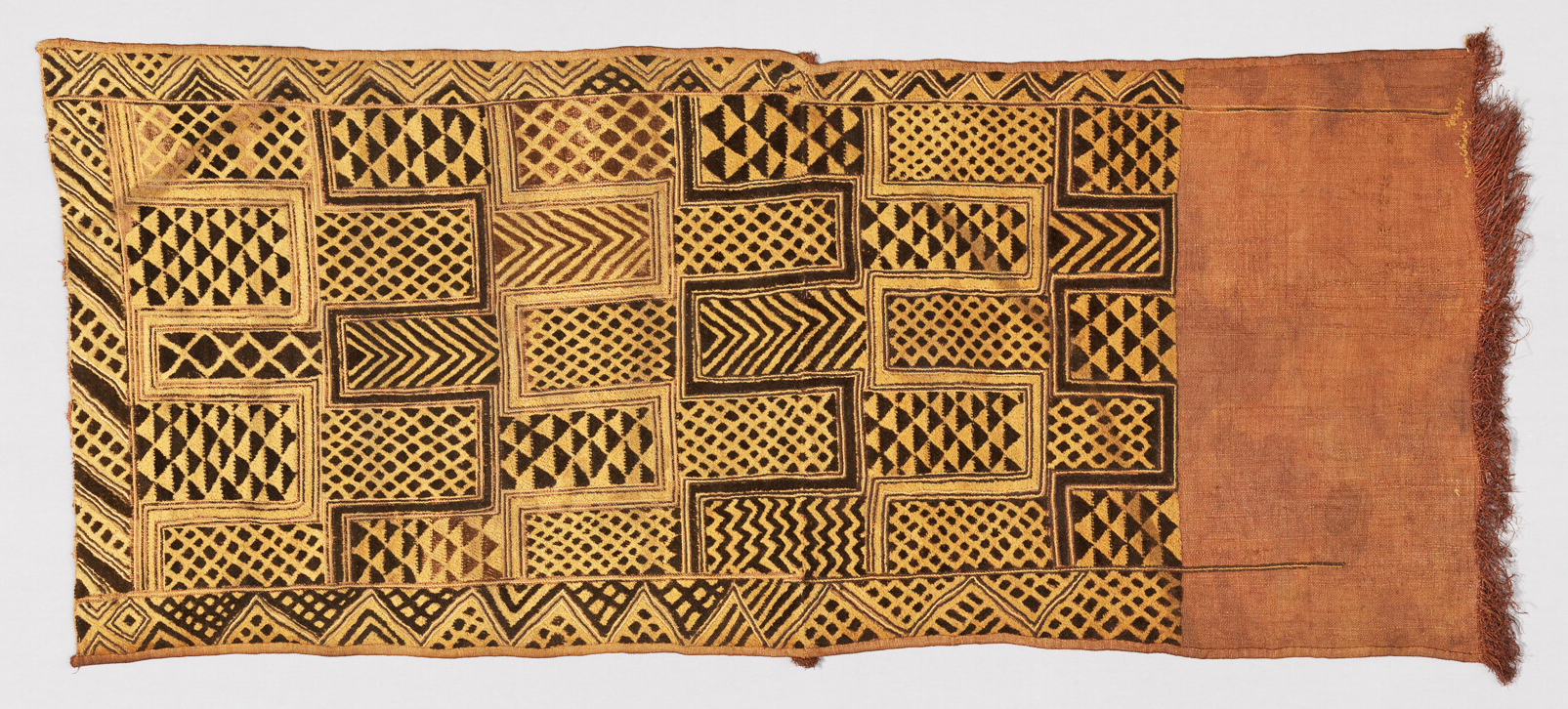
Kasaï Velvet textile, woman’s overskirt, Kuba people, Mushenge, DRC, 19th century. Dimensions: 130.5 × 57.8 cm – 51 3/8 × 22 3/4 in.
© The Art Institute of Chicago, IL, USA.
The above panel features a harmonious composition with a very well defined and constant rhythm – do you hear the ground bass, the basso ostinato of the drums? The central variation is restrained and not particularly distinctive in character.
Just as in music, variations can involve several aspects (melody, key, time signature, rhythm, chords, texture), so in Kuba abstract art, variations can change one or more aspects of a pattern at once (design, dimensions, color, texture of one or more elements). The panel below shows rather few variations, like the one above, but is musically very interesting. In addition, its relative simplicity helps us to feel the composition “musically”, training us to develop multisensory and synesthetic experiences. (If you want to know what they are, read The Pink Family: China and the West – Intermezzo 1).
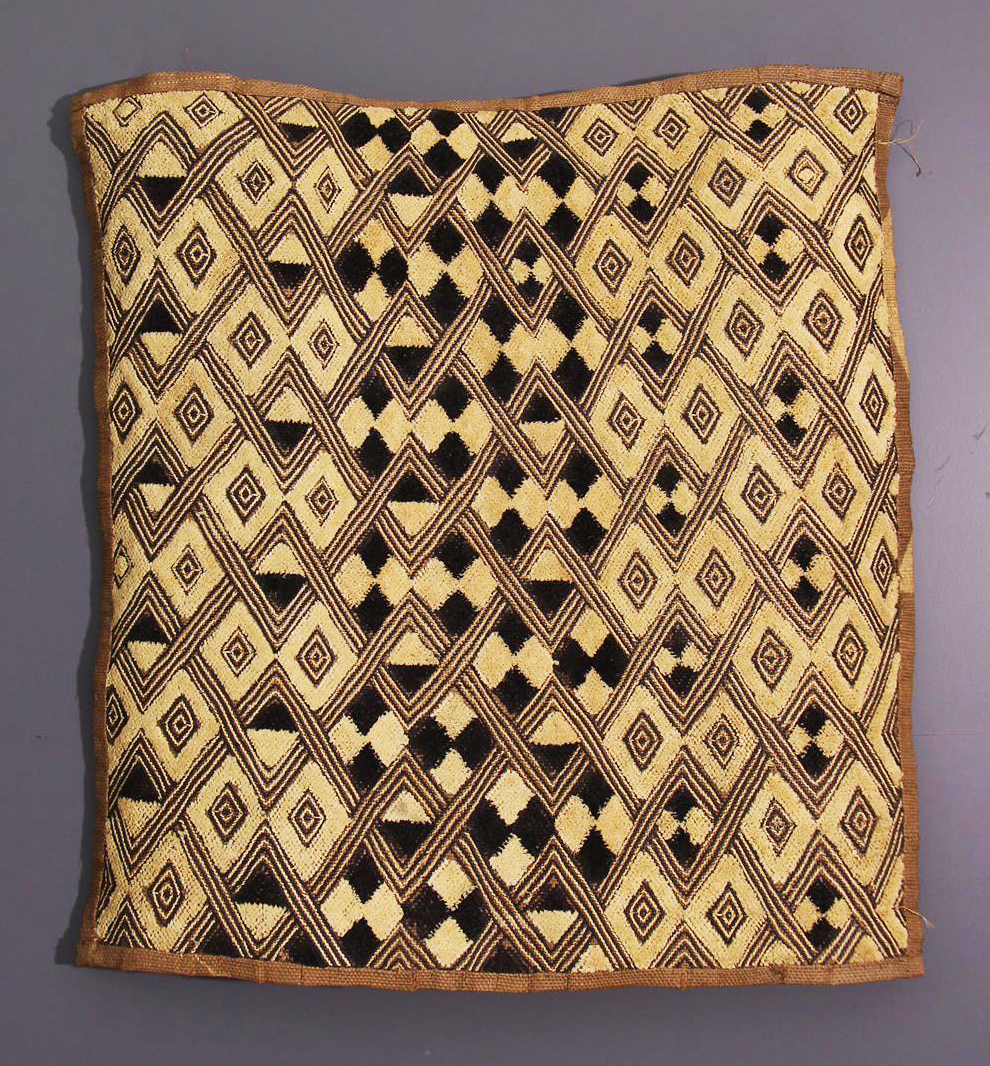
Shoowa panel, Kuba people, DRC, mid-20th century. Dimensions: 70 x 66 cm.
Photo courtesy of Patrick Malisse, owner of the African Art Gallery Essentiel Galerie – La Porte Dogon in Belgium.
The panel shows a clear ostinato: it’s the chevron motif, composed of four parallel lines that run horizontally and repeat vertically, overlapping and integrating a second melodic line, represented by the small diamonds. Starting from the left, we see a contrapuntal independent melody: the black triangles. At a certain point, the contrapuntal melody takes over and imposes itself on the ostinato bass, which remains in the background, while the second melodic line disappears. The situation does not remain stable for long, and the original composition is soon restored, but not in its entirety: the upper hand of the contrapuntal melody leaves a recognizable trace and changes the pieces forever.
The next elegant panel shows a much more decisive variation, which manages to surprise the observer or listener and confound their expectations.
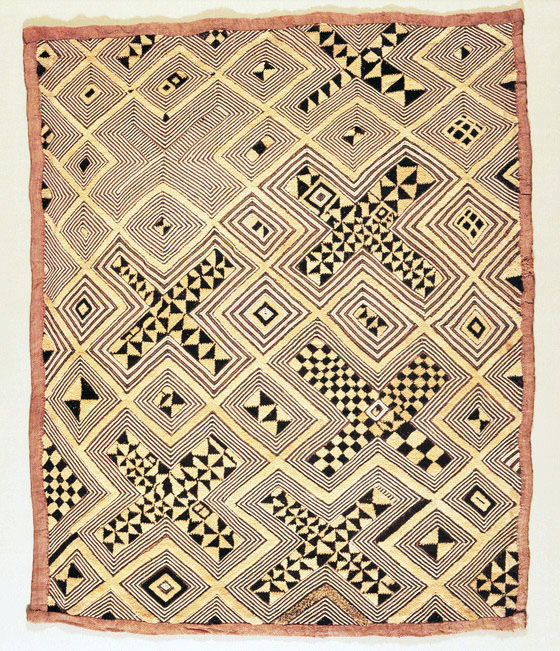
Ceremonial Textile Panel, Kuba people, DRC, mid-20th century. Dimensions: 71.76 x 59.06 cm – 28 1/4 x 23 1/4 in. LACMA Collection, Los Angeles County Museum of Art, CA, USA.
The ostinato here is not the cross, but the outline of each geometric figure (cross, square, rectangle) made up of four parallel lines. The variation here is consistent and incessant – where is this song taking me? – but the ostinato remains a reassuring element that gives the composition continuity, balance, and a degree of solidity beneath the surface dynamics. The result? A piece of extraordinary sophistication. Note that, according to Dorothy K. Washburn, one of the major expert on Kuba textiles, the use of parallel lines to outline a motif or border a pattern is an aesthetically pleasing element for Kuba people.
Below, you can see two ancient small panels with more complex variations.
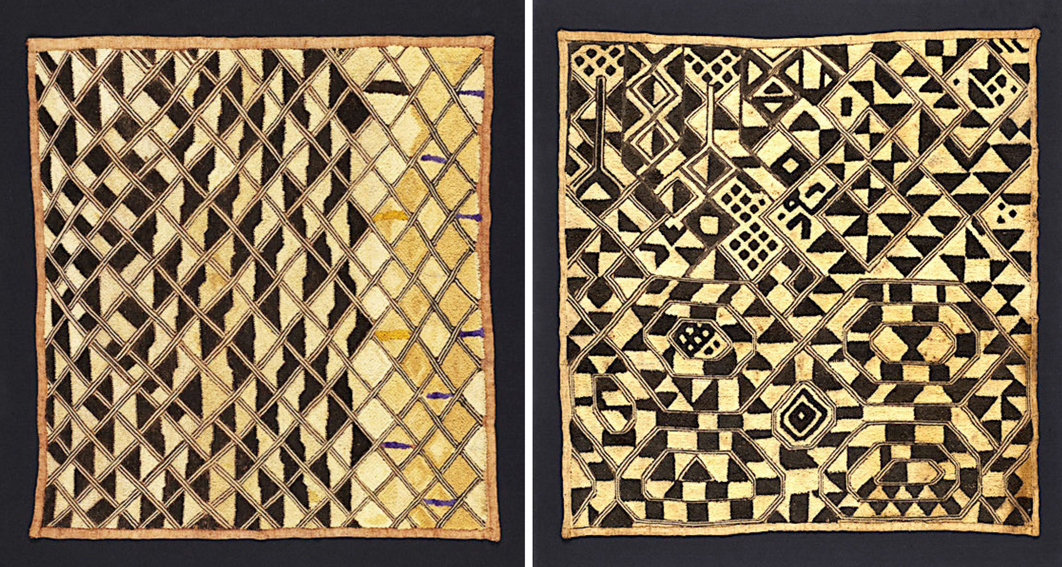
Shoowa Ceremonial Textile Panels, Kuba people, DRC, both late 19th-early 20th centuries. Dimensions: panel on the left: 59.69 × 63.5 cm – 23 1/2 × 25 in. Panel on the right: 64.77 × 69.85 cm – 25 1/2 × 27 1/2 in. Both are part of the LACMA Collection, Los Angeles County Museum of Art, CA, USA.
The panel on the left still shows an ostinato with highly dynamic contrapuntal elements and many variations in color, dimensions, and design. Some variations seem spontaneous and rich in many nervous, short and totally unexpected notes (the purple lines, for example). The left panel has a weak ostinato that disappears in the upper left part. Everything is constantly changing, nothing remains the same – no pattern repeats itself identically. Yet each of these two panels maintains a high degree of internal cohesion, and neither seems cacophonous or messy. Do you know what provides this cohesion? Rhythm. Each of the two panels has a well-defined and very recognizable rhythm. Do you hear it? Do you see it? The constancy of rhythm can help maintain structural coherence within a musical/visual composition, even when melodies and chords or patterns and colors change radically.
The following panels go far beyond more or less complex variations and have a much more intense emotional coloring. (The term “coloring” is used in both visual art and music, and despite their obvious differences, both serve to convey emotion or mood).
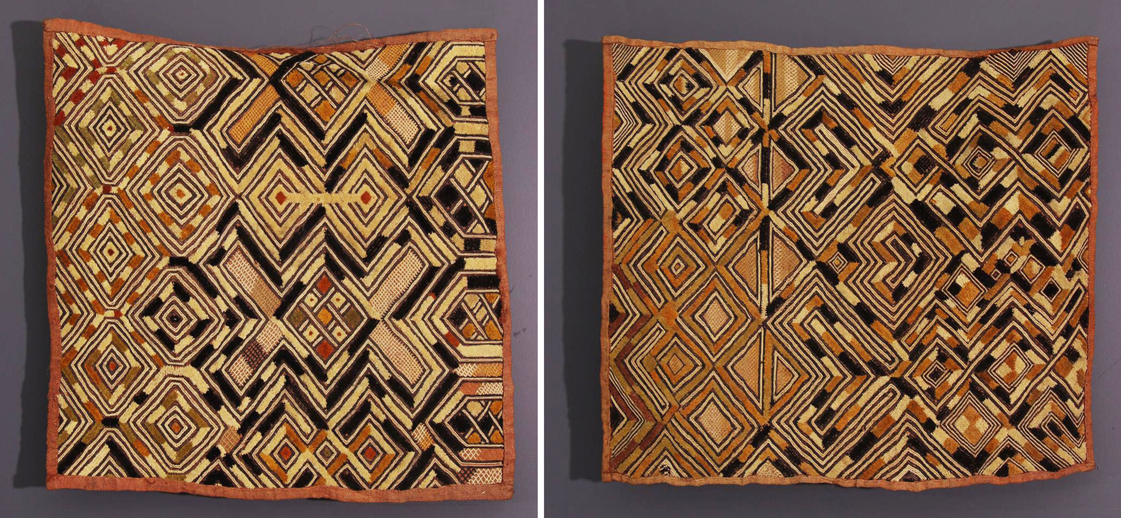
Shoowa panels, Kuba people, DRC, mid-20th century. Dimensions: left panel 51 x 49 cm; right panel: 50 x 63 cm.
Photo courtesy of Patrick Malisse, owner of the African Art Gallery Essentiel Galerie – La Porte Dogon in Belgium.
These two panels begin with some variations of the rhomboid motif on the left margin, but do not develop a more complex reinterpretation: at some point the motif disappears, and with it the ostinato.
Now look at how the colors play with each other in both panels. They do not follow any pattern, and even if you find two details that look the same chromatically, you only have to extend your view to the next centimeter to see that this is not the case. The colors here are an expression of spontaneity and emotion. The overall design is also much freer.
We are in the presence of something new and different: an improvisation.
In music, improvisation is the process of creating or performing music in the moment, without prior planning or sheet music. Improvisers may draw on known musical motifs or existing harmonic structures, but they add new elements, melodies, or variations in real time. Improvisation allows for the creativity and individual expression of the musician.
In this short video, you’ll hear a jazz improvisation (Western classical musicians cannot improvise).
Jazz Fundamentals: What Is Improvisation? – Jazz at Lincoln Center’s JAZZ ACADEMY
That moment of spontaneous creativity, similar to musical improvisation, can also occur in geometric design. The two panels above are an improvisation, a kind of creative exploration done by the artist in a state of flow. (What is a state of flow? Read The Tsuba, the katana and the samurai soul part 1 and you’ll know it). Improvising the unexpected is difficult and requires talent, experience, emotional depth, and confidence. Probably only a few Kuba women could improvise and express their creativity in full freedom. So if we call the two Shoowa above “jazz-style panels,” you know what I mean.
In music, the transition from one complex melody to another within the same piece can be accomplished by using various techniques: a segue, which is a smooth and seamless transition from one musical section to another without any pause or interruption; an interlude, a short section of music that serves as a bridge between two larger sections or melodies; counterpoint, a transition technique that involves creating contrapuntal relationships between the complex melodies; a ritardando or rallentando, which is a slowing down of the tempo; and so on.
The interlude is a musical link that provides contrast, continuity, or thematic development between the primary musical ideas. The following exquisite Shoowa panel shows an elegant transition between two different complex patterns. These are bridged by an interlude and linked by the contrapuntal use of background colors.
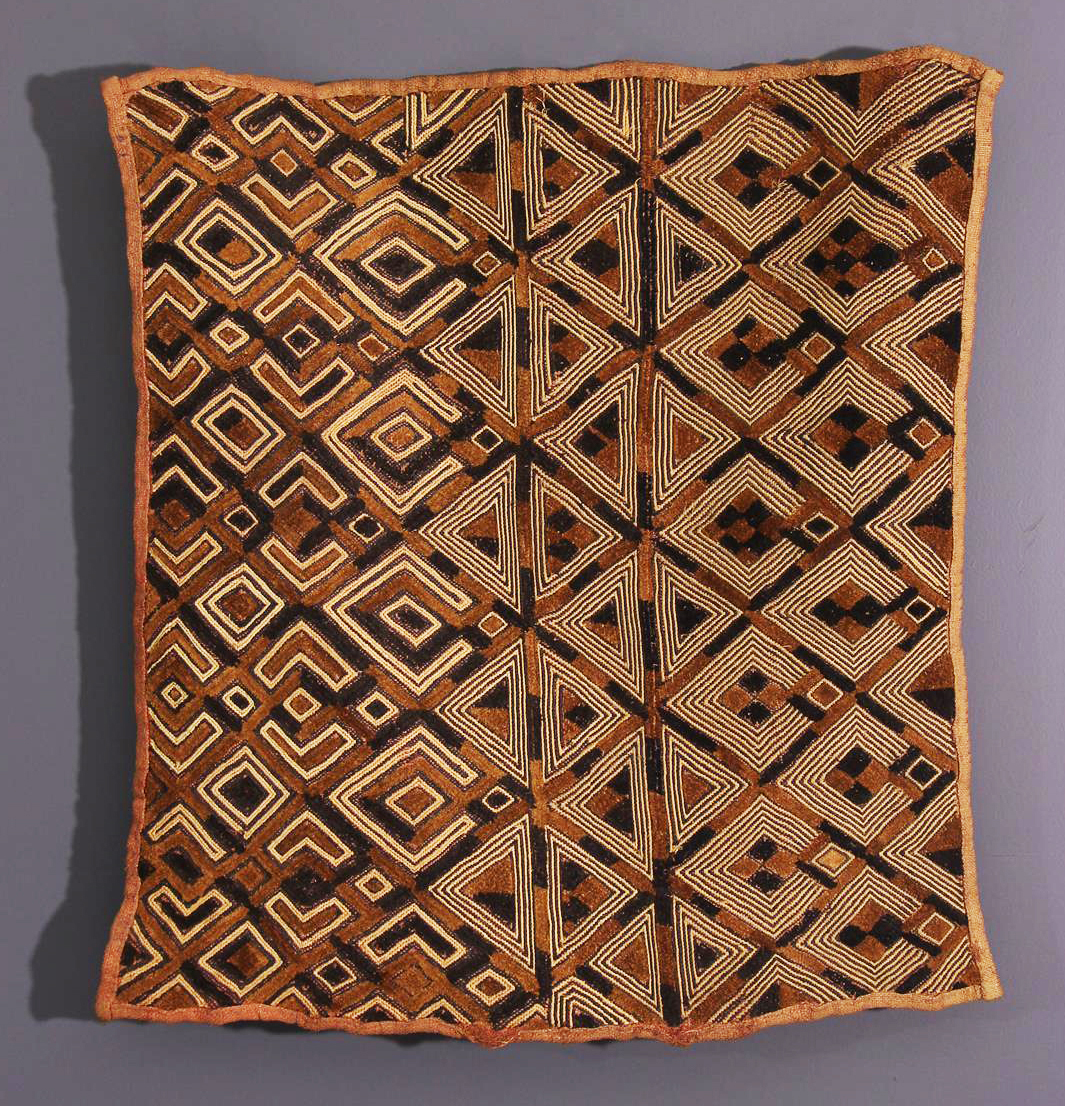
Shoowa panel, Kuba people, DRC, mid-20th century. Dimensions: 60 x 56 cm.
Photo courtesy of Patrick Malisse, owner of the African Art Gallery Essentiel Galerie – La Porte Dogon in Belgium.
In the panel below, the transition is more pronounced, even though the two melodic lines have similar proportions and some elements in common; the reason lies in the bridge or connector, which marks an abrupt interruption of all contrapuntal elements (it is colorless).
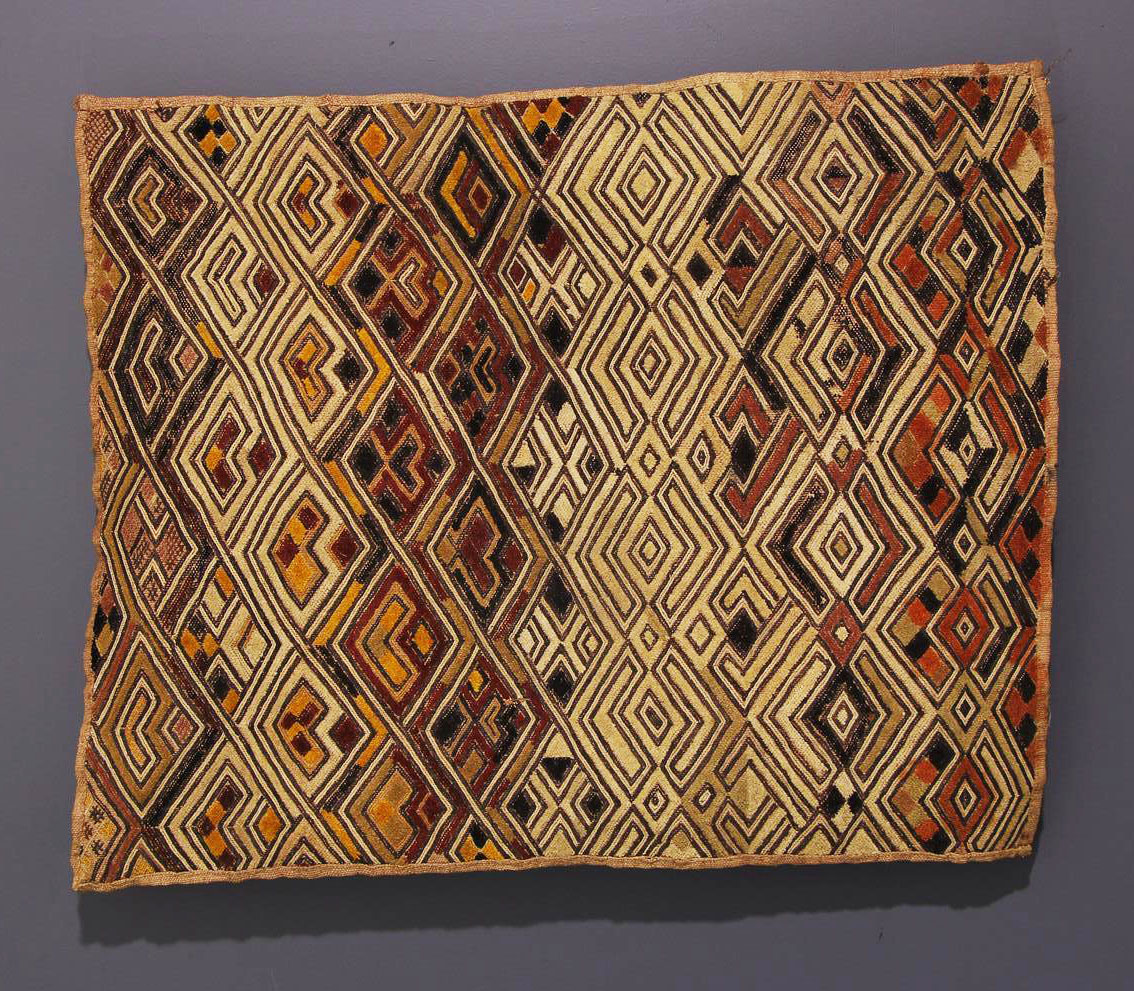
Shoowa panel, Kuba people, DRC, mid-20th century. Dimensions: 50 x 63 cm.
Photo courtesy of Patrick Malisse, owner of the African Art Gallery Essentiel Galerie – La Porte Dogon in Belgium.
Let’s continue the analogy between music and geometric design. Creative dissonance is the deliberate act of introducing contrasting or inconsistent elements into a musical or visual context to create a sense of tension, interest, and even surprise in the overall work.
In music, creative dissonance might involve the use of chords or notes that would not normally be considered harmonious, thus creating a contrast with more familiar tonalities. In geometric design, creative dissonance might involve a radical shift in the arrangement of shapes, sizes, or colors; it can also be realized through the insertion of a foreign pattern that breaks the existing visual coherence and creates tension. In both cases, whether in music or design, creative dissonance is a powerful technique for intentionally creating contrasts and eliciting an emotional or perceptual response from the viewer or listener. It can lead to a more intense emotional experience because it grabs our attention and breaks our expectations in a rather abrupt way.
Take a look at the panels below – you will quickly understand what I am talking about. They are not my favorite panels, but they show very clearly the use of creative dissonance.
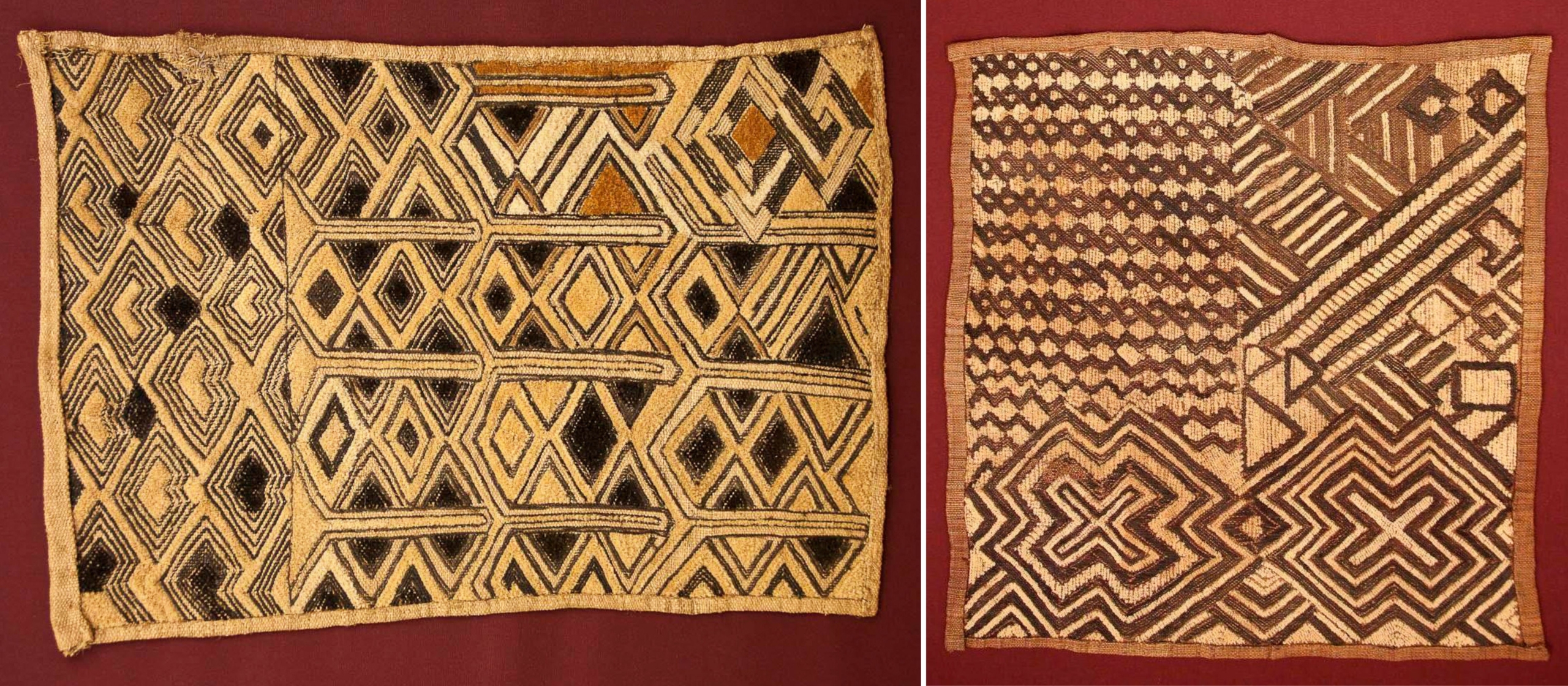
Kuba panels, DRC, unknown date. Dimensions: left panel length 21 in., width 14 in; right panel length 15 in., width 18 in. Photo courtesy of the Gregg Museum of Art & Design, Raleigh, NC, USA.
The left panel shows a first pattern with a contrapuntal element, an abrupt change of pattern, a flow of variations of the second pattern, and a small color and design dissonance in the upper left section. The color and the geometric shape burst in as alien and unexpected elements and wreaks havoc.
The creative dissonance is even more apparent in the right panel. Look at it by moving your eye from left to right. The panel is divided vertically into two parts; after looking at the first part, the eye expects to find a design that is perfectly symmetrical to the previous one, but instead it suddenly encounters a collection of elements that do not form a definite pattern or melodic line and have no harmonic or rhythmic relationship to the previous elements. It’s an intentional dissonance.
In music and in design, there is a technique that goes beyond creative dissonance and can be even more radical and entropic: the creative chaos or anarchic creativity. It involves the deliberate introduction of chaos in the form of disorganized, messy, irregular, and disconnected elements into an artistic context, such as music or design. These elements not only break with conventions, structures, and pre-existing expectations, but also create an intentional effect of disorder and involve a kind of visual or sonic entropy. They do not simply challenge the listener’s/viewer’s harmonic and rhythmic expectations as do variations, improvisations, or dissonances. They have a strong unsettling effect because chaos and entropic degeneration are highly disturbing elements. They shake up conventions and force the listener/viewer to reconsider their perspectives.
We are about to see an amazing example of entropic decay. It involves one of the most beautiful and common Kuba geometric patterns, so let us first recall it in all its glory. The Kasaï Velvet panel below is an exceptionally well-made prestige panel, probably a regale, and shows the pattern in some variations. (Regalia is the Latin name for the emblems, symbols, insignia and paraphernalia of royalty, as well as rights, prerogatives and privileges enjoyed by a sovereign. Regale is the singular form.).
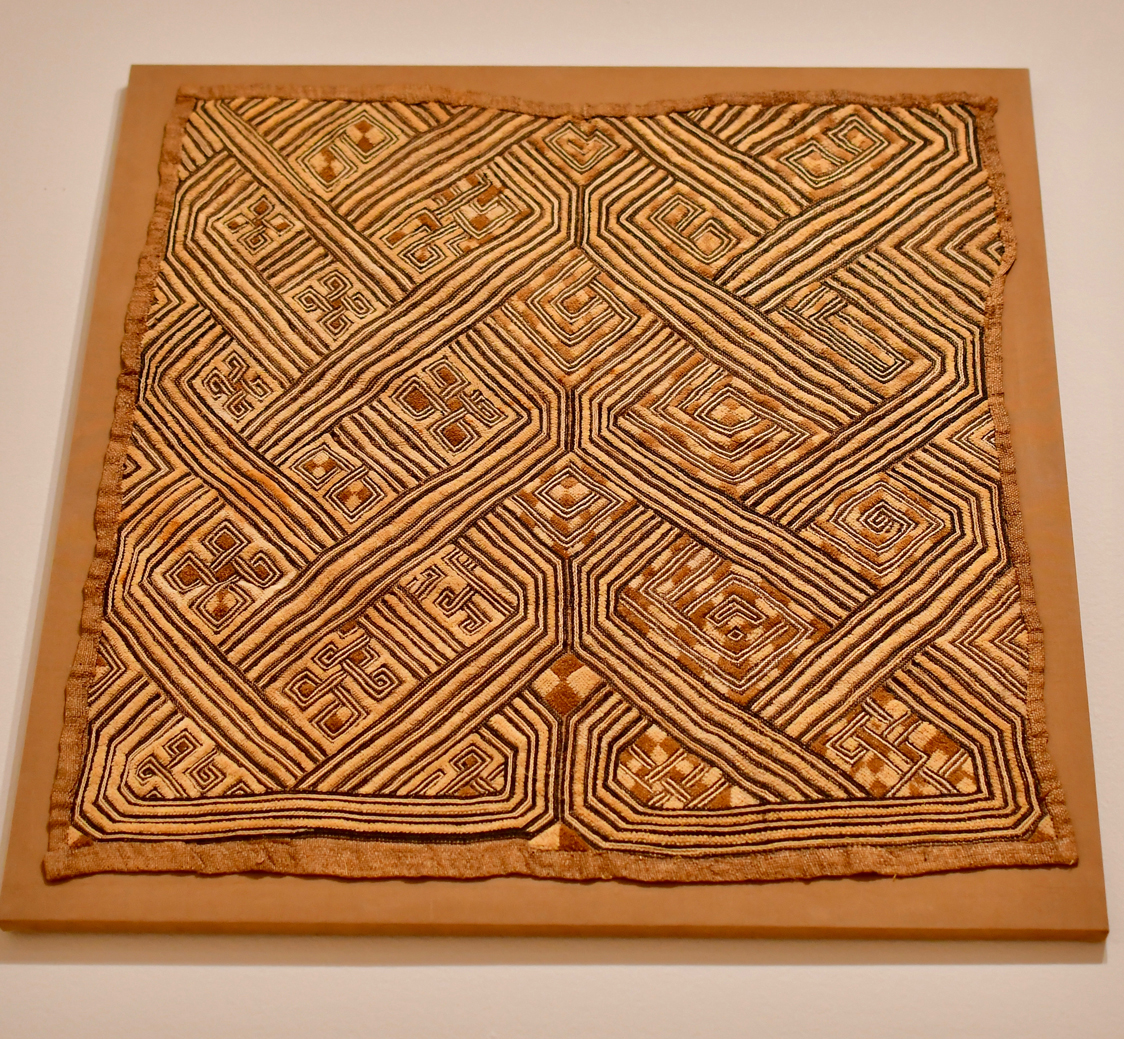
Prestige panel, Kuba people, DRC, 1962-1979. On display at the 2018-19 exhibition Kuba: Fabric of an Empire, BMA’s Cone Collection galleries. ©Photo by Kerr Houston / Baltimore Museum of Art, MD, USA.
Photographing a panel from this angle has some advantages: the three-dimensionality of the cut-pile velvets comes out very well. This prestige panel has been masterfully crafted and shows such a degree of symmetry and regularity that the continuous variations are hardly noticeable.
The following image shows two interpretations of the same pattern.
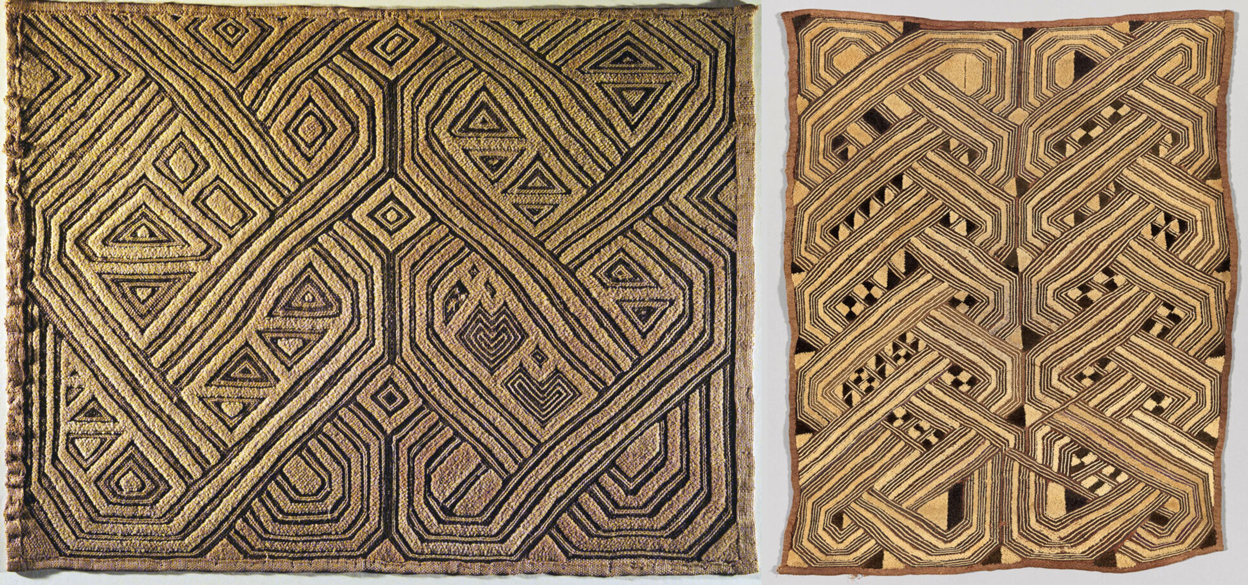
Left: Shoowa panel, Kuba People, DRC, 20th century. Dimensions: 45.1 x 60 cm – 17 3/4 x 23 5/8 in. Brooklyn Museum, NY, USA.
Right: Kuba panel, DRC, early/mid–20th century. Dimensions: 61 × 49.2 cm – 24 × 19 3/8 in. The Art Institute of Chicago, USA.
Now, here is the “entropy” panel.
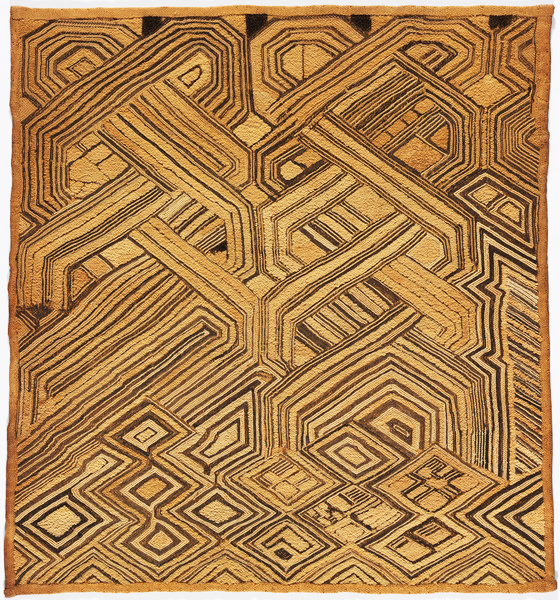
Ceremonial Panel, Kuba people, DRC, late 19th-early 20th centuries. Dimensions: 66.04 x 71.12 cm – 26 x 28 in. LACMA Collection, Los Angeles County Museum of Art, CA, USA.
Let’s look at it from top to bottom. From the beginning, the pattern defies all expectations: it’s uncertain and unclear; the parallel lines multiply incongruously, confusing the design and unraveling the contours. Everything seems to drip down at random and eventually liquefy. The pattern melts and transforms into something else, another pattern that still looks uncertain in its first movements.
Fascinating, isn’t it?
A complex pattern that seems to lose its composure and order look at the lower left corner) and then ‘liquefy’ is also shown in the next panel. (Please, note that this is not a Kasaï Velvet, but an entirely broidered panel).
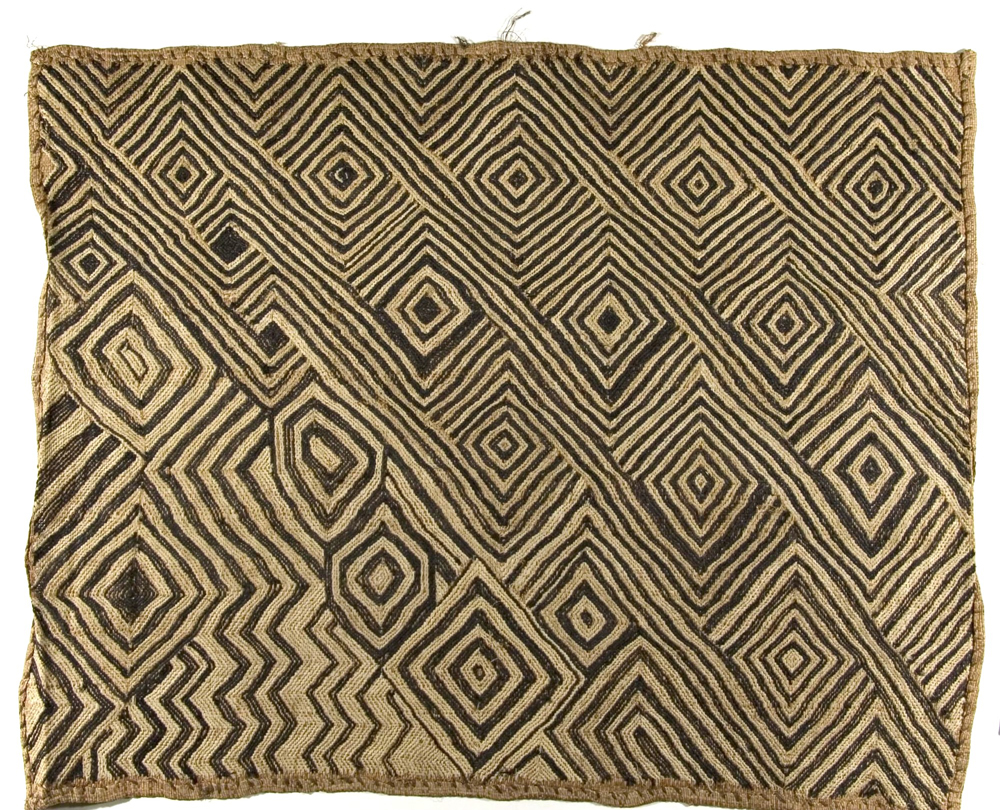
Export design panel, Kuba people, Democratic Republic of Congo, 1980s. Overall dimensions: height 45.6 cm, width 37 cm (17 15/16 x 14 9/16 in). Princeton University Art Museum, USA.
Below you can see another “entropy” panel with a disturbing effect.
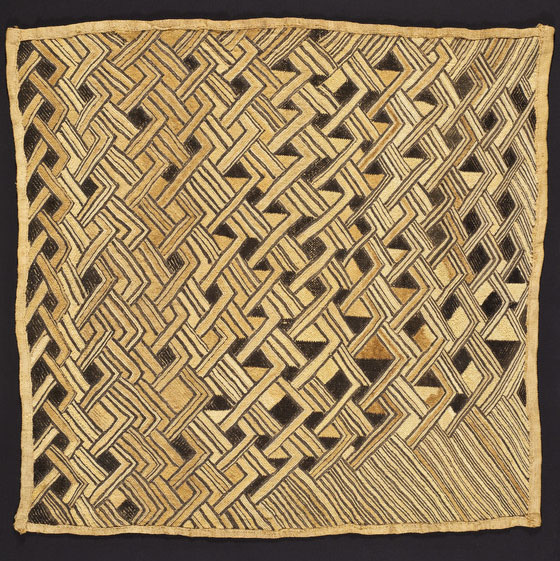
Ceremonial Shoowa Panel, Kuba people, DRC, late 19th-early 20th centuries. Dimensions: 64.14 × 71.12 cm – 25 1/4 × 28 in. LACMA Collection, Los Angeles County Museum of Art, CA, USA.
Here, the complex pattern and all its variations are quite well defined. The rhythm and melodic lines are clear and distinct; but let’s look at it from left to right. At one point, the pattern unravels, giving rise to a series of parallel straight lines at the top, bottom, and also at the far right (we see it dimly because the panel has been cut off). You know how on the hospital multiparameter monitor the heart rhythm unravels and gives rise to a straight line? In this panel, too, the rhythm stops. The melodies disappear. What was once vibrant and alive loses its energy. No more notes, now. Only the monotonous and repetitive alarm sound of the monitor. Then silence.
We used musical analogy as a key to unlock the complexity of the Kasaï Velvet panels. Many of the musical elements, concepts, and techniques we used in our analysis, such as counterpoint, counter-melody, and ostinato variation, are well represented in traditional sub-Saharan music.
It has been said that African music is characteristically complex by Western standards. One of the many reasons for this is the African love of improvised variations, one of the most fundamental principles of all Central African music and one of the major aspects of its differentiation from Western classical music. Improvisation is often incorporated into musical performance, allowing musicians to explore and develop musical ideas in the moment, rather than following a predetermined score. This allows for creative flexibility and a more immediate connection to emotional expression. Improvisers can change melodies, rhythms, and musical forms in real time, creating unique performances. Variations can be seen as a form of creative exploration within a melody or theme. Sub-Saharan African musicians often take a basic theme or melody and vary it by adding new melodies, rhythms, or sonic nuances. This process of variation may occur during the performance itself or as part of a larger musical tradition. In addition, sub-Saharan African music often places a strong emphasis on communication and interaction between musicians (as in jazz). Improvisation and variation allow musicians to respond dynamically to the expressions of other participants, creating a real-time musical dialogue. All of this contributes to a very flexible, vibrant, and emotionally engaging form of musical performance that is rooted in the oral and cultural traditions of local communities.
Are you still surprised by the richness of variation, color, and free improvisation in the Kasaï Velvets?
Kuba traditional dance and music
Let us look at an astonishing single panel made in the 1980s and held by the Princeton University Art Museum. It dances before my eyes. And it also plays music. It appears to be complex musical compositions with polyrhythmic elements (= with several simultaneous rhythms in the music, which can create a sense of complexity and rhythmic interest), polyphonic interweaving (= with several independent melodic lines or voices interwoven in the composition), and an intricate texture rich in emotional nuances, variations, changes, and different kinds of transitions. It’s an African musical and visual masterpiece.
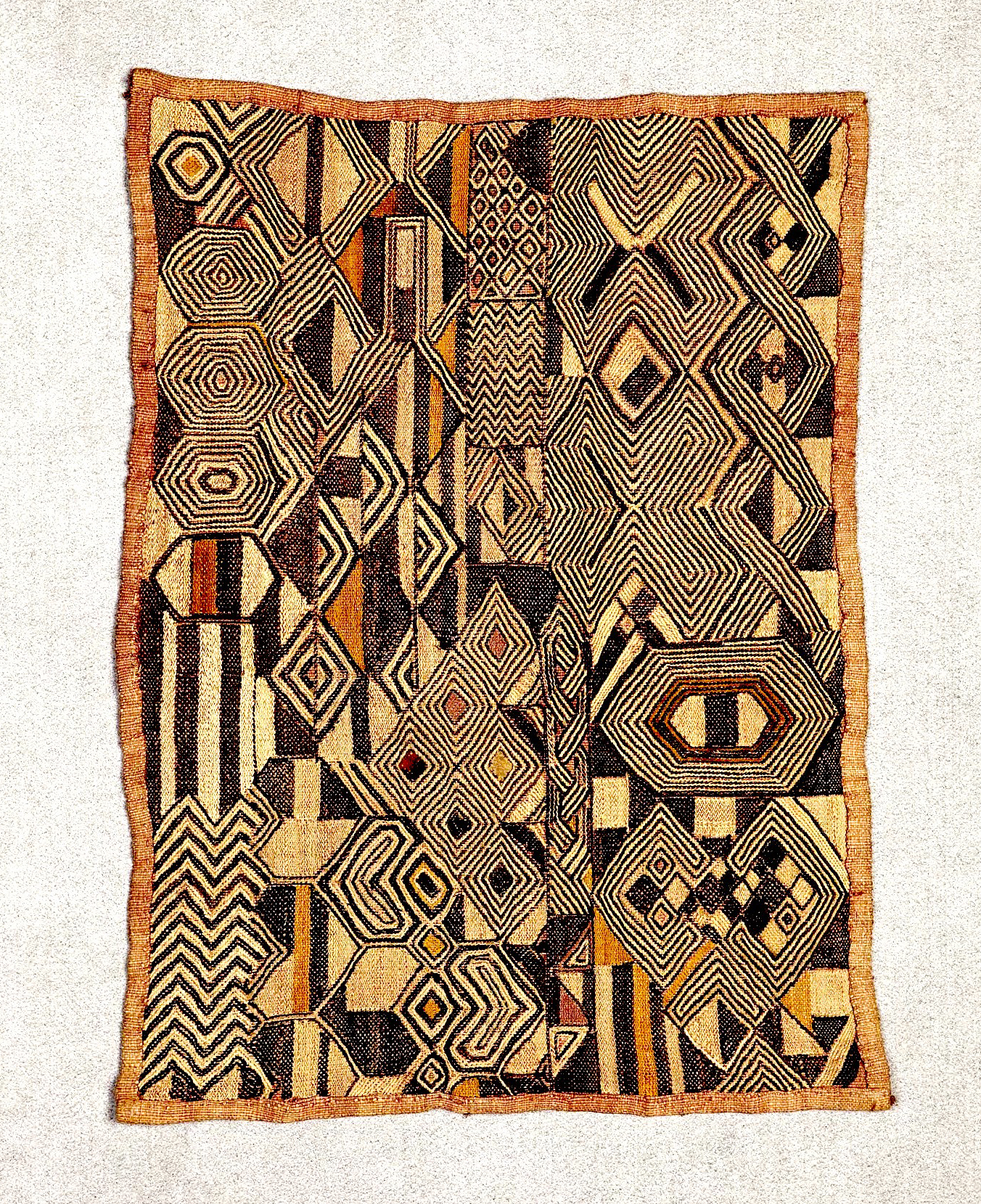
Export design panel, Kuba people, Democratic Republic of Congo, 1980s. Overall dimensions: 48.8 x 36 cm (19 3/16 x 14 3/16 in). Princeton University Art Museum, USA.
Now let’s play a game.
Look at the same panel in a black frame that cuts through the hem of the fabric and turns it into a canvas. You are told that the work is a painting called Synesthesia no. 76 and is the masterpiece of a brilliant German artist who attended the classes of Paul Klee and László Moholy-Nagy at the State Bauhaus in Weimar between 1924-25 and died very young.
Can you believe it?
And what does it change?
How do your eyes change?
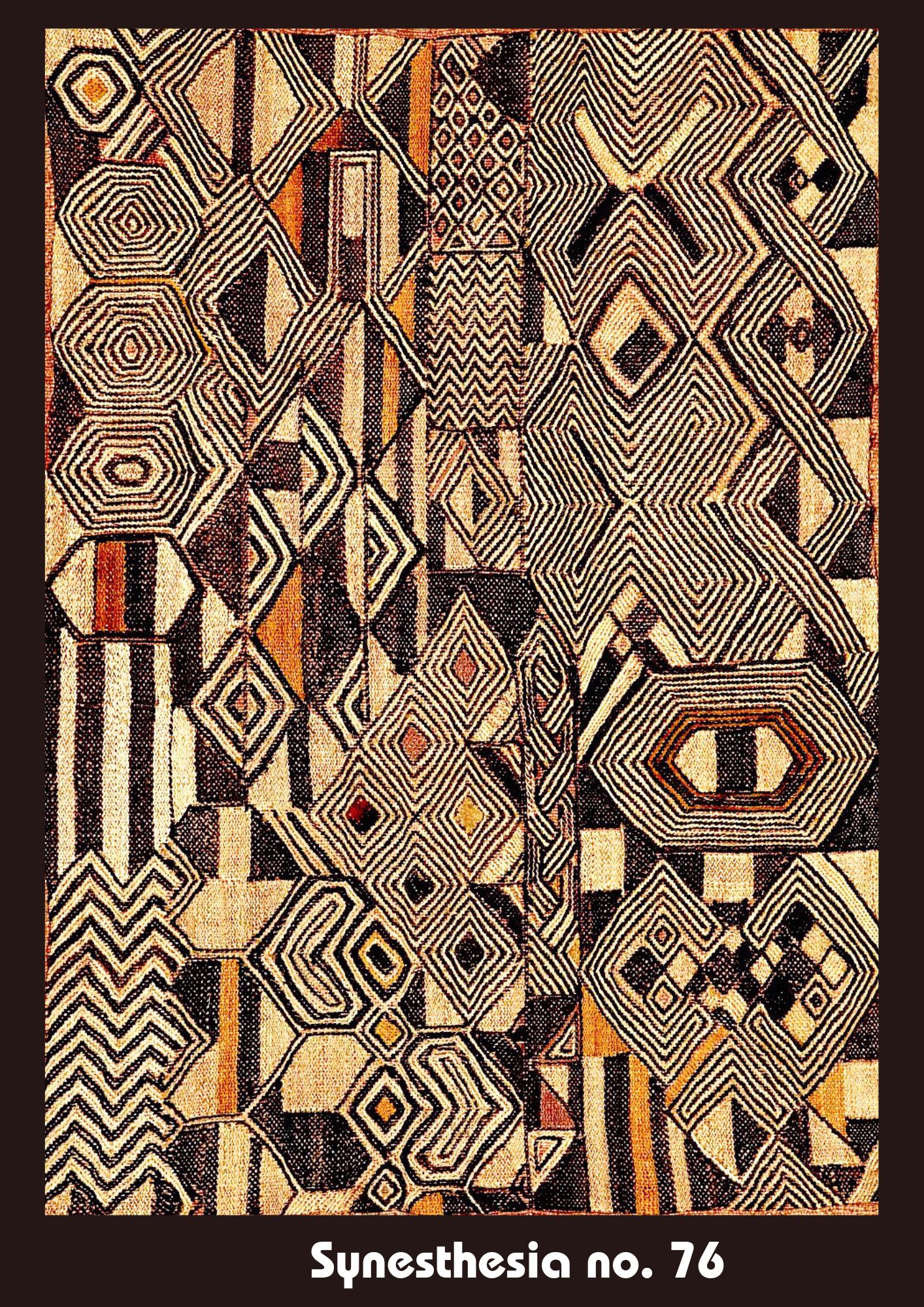

THE MANY KEYS TO UNDERSTAND SHOOWA PANEL COMPLEXITY
As we have said, we have used musical analogy as a key to penetrate the “intricacies” of Kasaï velvets. This is not the only key that has been and can be used: like all kinds of complexity, that of Kuba textiles requires multiple interdisciplinary perspectives.
THROUGH A MYSTERIOUS IMAGERY
In the cultural tradition of Kuba, many geometric patterns (about 200) have a name, and some of them also have a history and a meaning. They are signs, symbols, emblems, and form a visual symbolic language in which even colors and the creation of contrasts through the use of light and dark tones gain significance. According to American expert Ashley Rickman, the use of interlocking hooks, for example, symbolizes the act of a mother embracing her child.
The most recurring basic pattern, which has many variations, is the woot or woto.

The Bushoong woot pattern and some of its variants: A the basic woot; C woot matul, festive woot; D ikuun i yoongdy, or “the chameleon’s belly”; 12 and 13 composition of woot pattern. C, d, 12, and 13 are taken from Georges Meurant, Shoowa Design (cit.).
BELOW
The woot pattern and some of its variations: Raffia Textile, Kuba people, DRC, 20th century. Dimensions: 54 x 53 cm – 21 1/4 x 20 7/8 in. Michael C. Carlos Museum, Emory University, Atlanta, GA, USA.
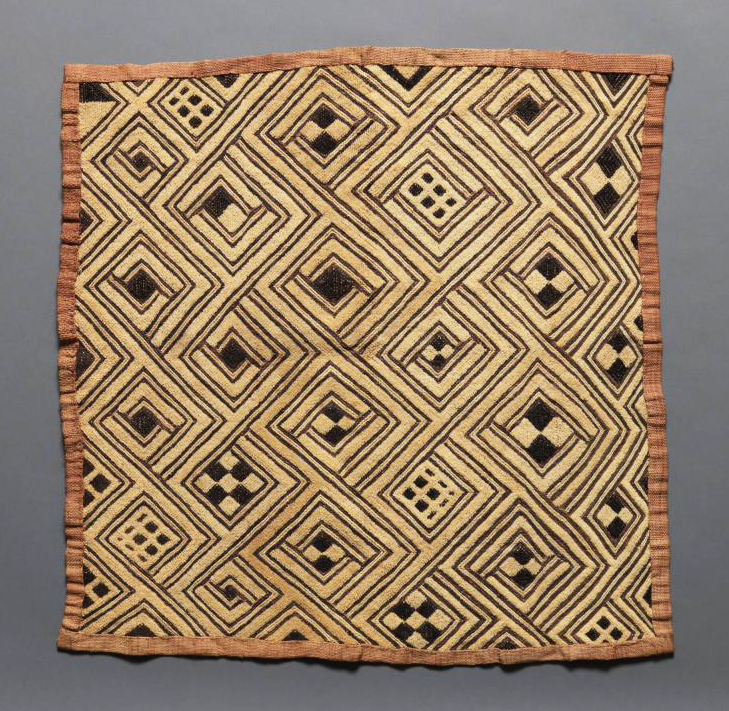
Woot or Woto is the mythical hero and ancestor of the Kuba peoples, all “children of Woot”. He gave species names to animals and plants, and a proper name to each human being, thus distinguishing them from other living beings. «Woot and his nine sons introduce discontinuity between nature and culture. (…) He founded culture, discovered the symbols of power» (Georges Meurant, op.cit.) and established the matrilineal succession to it. Woot is therefore a central figure not only in the mythology of the Kuba, but also in the in the narrative of their identity and unity in difference.
Hylan Booker, in an article titled Geometry of the Kuba, published on “Unframed”, the LACMA’s blog, wrote in 2011: «It could be suggested that Woot, the first man, a pattern of utter intricacies, is feared, honored, and worshiped through the complex though dazzling displays of geometrical signs». Can we assume that some panels may allude to or visually represent mythological tales or genealogical stories that are foundational to the Kuba peoples?
The woot pattern in all of its variations is often linked, connected, superimposed, metamorphosed into another common and relevant symbol, the imbol or mbol. «Strictly speaking, it’s the interlacement of two crossed circuits or of a line knotted on itself.» (Georges Meurant, cit.)

The imbol pattern and some of its variations from Georges Meurant, Shoowa Design (cit.).
BELOW
Imbol pattern and variations. Left to right: 1. The British Museum; 2. Moraga Collection; 3. and 4. The Van Rijn Archive of African Art, at the Yale University Art Gallery.
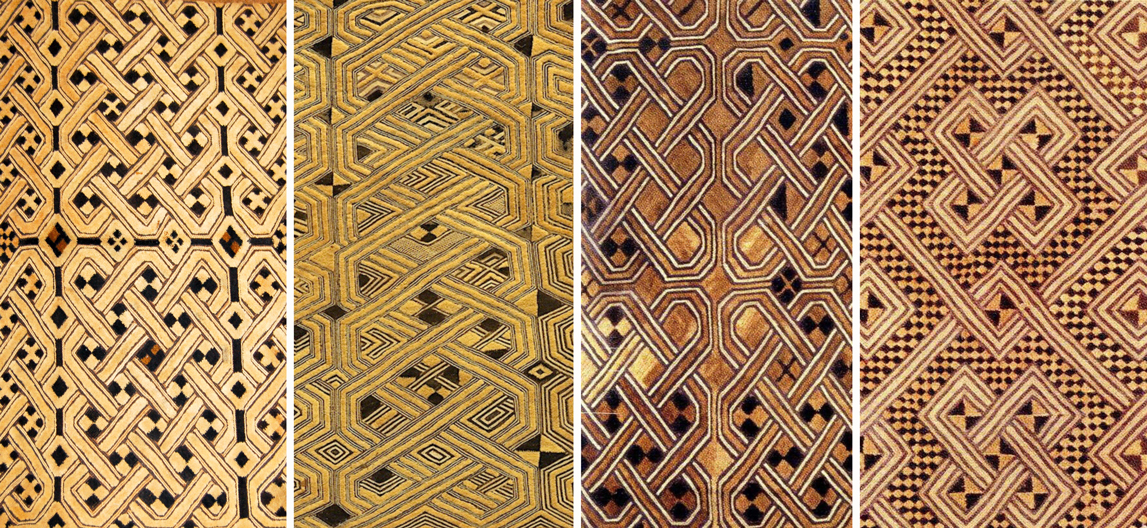
The knotted line is a complex symbol in many cultures. In their recent volume, Knots: Ethnography of the Moral in Culture and Social Thought (2023), David Lipset and Eric K. Silverman point out that «the meanings of cultural knots might be seen as bound up with the very moral processes that make nothing less than self and society possible.» Belgian anthropologist Filip De Boek, an expert on Africa, wrote that in Central Africa, the idea of life and life force is conceptualized in terms of the joining or knotting of male and female (2013).
The Kuba nyim (king) wore a belt called a mwandaan, which had two large knots on it. Could the two knots represent, on the one hand, the political, social, and moral ties that unite the peoples of Kuba, of which the king is the guarantor and protector, and, on the other hand, the secret connection between the sensual and spiritual worlds, of which the king, by virtue of his divine nature, is the repository? And if so, what might the panels depicting the imbol or some of its variants symbolize? Do they bring to light the hidden structures and multiple connections that lie beyond physical reality?
The American scholar Ashley Rickman defined the Kuba raffia textiles as “a medium of cultural and spiritual communication”. What kind of narrative were they trying to convey? Is Georges Meurant right when he writes that «it can be said that design is a mode of thought which cannot be put into words.»?
It is difficult to answer all these questions because it is difficult to understand how these panels ‘resonated’ with the people for whom they were created. Part of the oral culture of the Kuba people was lost because it could not withstand the violent and destructive impact of Belgian colonialism, the bloody post-colonial conflicts of the 20th century, globalization, the merciless forms of neo-colonialism of the 21st century, and the political and social instability of one of the richest and poorest countries on the continent (the two, wealth and poverty, always go together, like the North Pole and the South, or the right hand and the left).
Even today’s Kuba elders could remember only fragments of the visual language shared by the various Kuba groups and subgroups, and probably nothing of the local variations and unique nuances used by groups other than their own.
THE MATHEMATICAL APPROACH TO COMPLEXITY
Geometric patterns are inherently amenable to mathematical analysis. As we’ve already noted, 12 of the 17 possible ways to vary a pattern symmetrically on a surface are found in Kasaï textiles, along with examples of 7 of the 7 possible symmetries in borders. However, the main feature of most 20th-century “velvets”, with some exceptions as we’ll see, is represented by a series of asymmetries, variations, improvisations, irregular and broken patterns, transitions, dissonances, creative caos, and entropic degeneration processes. These factors allow the patterns to change and evolve, to tell a story if we want to use a different key, or to represent a unicum in the history of world design if we want to use an even different key. All these factors and the intrinsic dynamism of Shoowa panels pose a challenge to the mathematical analysis and computational approach of shape grammars. Some scholars focus on geometric transformations (e.g., translations, rotations, or scaling) to understand how patterns evolve or change within the panels.
In a 2004 Canadian collaborative study, entitled Textiles, Patterns, and Technology: Digital Tools for the Geometric Analysis of Cloth and Culture, Sushil Bhakar (a computer science researcher), Eric Hortop (a mathematician), Cheryl Kolak Dudek (associate professor of Print Media), Sylvain Muise (Applied Mathematics expert), and Fred E. Szabo (professor of Mathematics) wrote: «Fractal symmetry, including recursion, scaling, self-similarity, infinity, and fractal dimension, is displayed in the Kuba designs through juxtapositions of linear embroidery, velvet forms, and contrasting color that becomes counterpunctual in the composition. According to Ron Eglash, fractals are part of African numerical systems as evidenced in their village planning, decorative motifs and textiles. He specifically describes Kuba designs in the computational terms of a complexity spectrum:”These [Kuba designs] tend to show periodic tiling along one axis, and aperiodic tiling—often moving from order to disorder—along the other. Similar geometric visualizations of the spectrum from order to disorder have been used in computer science». (Textiles, Patterns, and Technology: Digital Tools for the Geometric Analysis of Cloth and Culture, see Bibliography).
Ron Eglash is an American expert in cybernetics and professor at both the School of Information and the School of Design at the University of Michigan (USA). He’s the author of the renowned essay African Fractals: Modern Computing and Indigenous Design. New Brunswick: Rutgers University Press, 1999. In the final BIBLIOGRAPHY, you’ll find all details to get these works as well as the others quoted here.
The most interesting line of research is that of “ethnomathematics”. The leading scholar in this field, the late Paulus Gerdes, a Dutch mathematician and rector of the Pedagogical University of Mozambique, explains what it is: «Ethnomathematics is a discipline that studies mathematics and mathematical education as embedded in their cultural context. (…)». The application of historical and ethnomathematical research methods has contributed to a better knowledge and understanding of mathematics in the history of sub-Saharan Africa, as well as to an awareness of further mathematical elements in African traditions.». (On Mathematics in the History of Sub-Saharan Africa 1, see Bibliography). The development of ethnomathematics is essential to the discovery of “hidden” geometric ideas: « Many mathematical ideas and activities in African cultures are not explicitly mathematical. They are often intertwined with art, craft, riddles, games, graphic systems, and other traditions, so that the mathematics remains ‘hidden’ or ‘implicit’.». (Ibid.). An example of the results of this new approach is shown by Paulus Gerdes himself in relation to the Shoowa textile.
In his volume Ethnomathematics and Education in Africa, Gerdes considers some Kuba patterns and shows how these designs can serve as an interesting starting point for the study of geometry. In particular, he considers a basic pattern called mongo by the Ngongo and mwoong or “elephant defense” by the Bushoong (both are ethnic groups within the Kuba confederation), and shows that by repeating this pattern, one can geometrically discover and easily prove the theorem of Pythagoras.
Below, the mongo pattern according to Georges Meurant and some of the pages dedicated by Gerdes to the demonstration of the theorem mentioned.
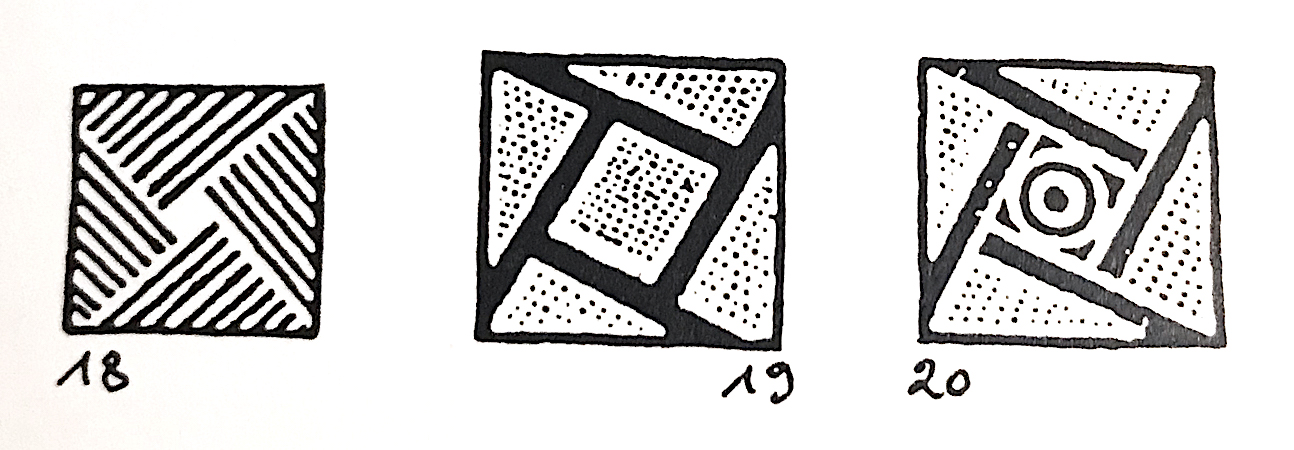
Ngongo pattern, mongo or “knee”; 19. and 20. Bushoong patterns: Mwoong or “the elephant’s tusk”; Ikwaak L’imwoong or “the crooked elephant’s tusk”. From Georges Meurant, Shoowa Design (cit.).
BELOW
Paulus Gerdes, Ethnomathematics and Education in Africa, 2014, pp.100-103. Click on this link to read the book online on the Calaméo website.
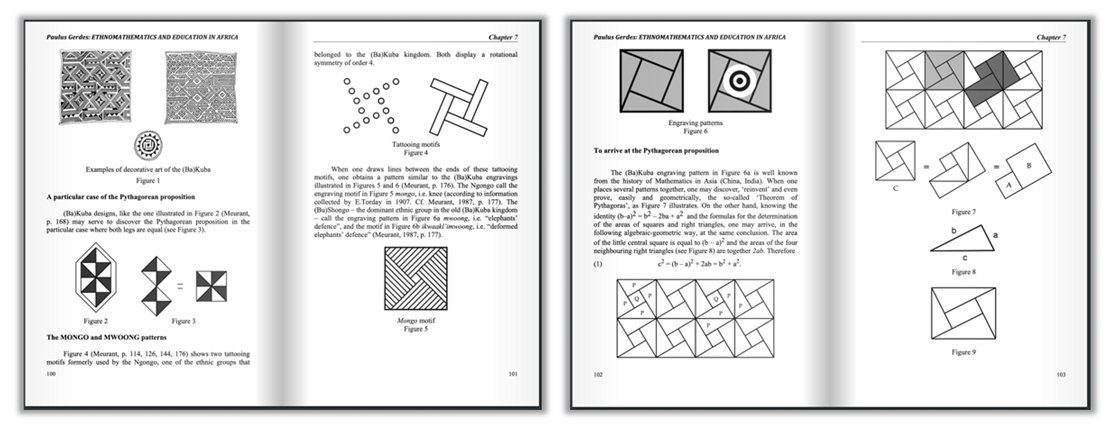
Whenever we discover the existence of rules for generating and combining patterns, we can say that we are dealing with forms of applied mathematics. It’s fascinating but we won’t delve into the mathematics underlying complex combinations of Kuba patterns. We will take another path that reveals other aspects of the complex Kuba art.
«Shape and number are not only the universal rules of measurement and logic; they are also cultural tools that can be used for expressing particular social ideas and linking different areas of life. They are, as Claude Levi-Strauss would put it, “good to think with.”» (Ron Eglash, African Fractals: Modern Computing and Indigenous Design, 1999, see Bibliography).
MORAL, SOCIAL AND POLITICAL GEOMETRIES
Kasaï velvets, and all Kuba textiles in general, were an integral part of a cultural universe populated not only by other artistic expressions and cultic objects, but also by gestures, ceremonies, festivals and rituals (of enthronement, initiation, burial, etc.), each of which had a specific function, meaning, and relationship both to each other and to the whole. This complex and highly dynamic network of connections continuously fed a sphere of meanings that was diachronically fluid (= changing over time), but synchronically (= at any given moment in time) shared by all Kuba peoples. Through this shared heritage, they could make sense of the world and each other, and find unity in diversity (= find their common Kuba identity beyond their differences).
Seen from this angle and analyzed with this key, the Kasaï velvets will tell us intellectually surprising stories.
It has been said that “the woven art of Kuba was a tangible representation of the abstract concepts of privilege and power. (Ashley Rickman, among others).
We will see how the geometrization of space that characterizes Kuba art can be seen as a visual representation of the organization of Kuba society according to a particular hierarchical structure that has its guarantor and axis in the figure of the nyim. However, it would be an unforgivable mistake to limit Kuba abstract art to this representational function. Together, we will discover how Kuba abstractionism has historically constituted the only possible language through which the Kuba peoples could represent themselves to themselves and to the world. Only abstract art could, in fact, give an “audible” and lasting voice to the moral order of which the nyim was the guardian and “divine” protector. This moral order, which in the Kuba founding myth became a necessity when Woot, the founder of culture, severed the umbilical cord with nature and let evil into the world, represents the condition of survival and the core identity of the complex Kuba compage.
Pierre Kwenders – Heartbeat ft. anaiis, from the 2022 album José Louis and the Paradox of Love
Pierre Kwenders is the stage name of José Louis Modabi, who was born in 1985 in Kinshasa, DRC, but currently lives in Canada. A songwriter, musician, and singer (who sings and raps in English, French, Lingala, and Tshiluba, the last three being official languages of the Democratic Republic of Congo), Kwenders is known for blending African rhythms with Western pop, hip-hop, and electronic music to create his own style. Anaiis (stylized anaiis) is a French-Senegalese singer-songwriter based in London. The music video was shot in July 2021 on a sheep farm in East Sussex, UK.

Alyx Becerra
OUR SERVICES
DO YOU NEED ANY HELP?
Did you inherit from your aunt a tribal mask, a stool, a vase, a rug, an ethnic item you don’t know what it is?
Did you find in a trunk an ethnic mysterious item you don’t even know how to describe?
Would you like to know if it’s worth something or is a worthless souvenir?
Would you like to know what it is exactly and if / how / where you might sell it?
